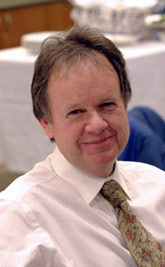

Friday - June 4, 2010
SLAC Today is
available online at:
http://today.slac.stanford.edu
In this issue:
From the Director of Photon Science: Photon Science at SLAC—A Vision for the Future and First Steps
Word of the Week: Gluino
 |
 |
|
Friday - June 4, 2010 |
From the Director of Photon Science: Photon Science at SLAC—A Vision for the Future and First Steps SLAC's transition to a true multi-program laboratory progresses at a very rapid pace. The remarkable success of the Linac Coherent Light Source and the discoveries that it will enable, the prolific delivery of science from the Stanford Synchrotron Radiation Lightsource and its impact on energy-relevant problems, and the seminal results coming from the Fermi Gamma-ray Space Telescope and the focus of the Particle Physics and Astrophysics Directorate in leading a diverse set of new experiments seeking to understand dark energy and dark matter, all provide very strong and positive evidence of SLAC's diversification and evolution in mission. At the core of this change, the new Accelerator Directorate is delivering excellence in support of accelerator operations coupled with advanced accelerator R&D. This is all being strongly facilitated by the progress in operations excellence in important areas of mission support. So what about Photon Science at SLAC? In the words of SLAC Director Persis Drell, "To achieve its goal as a leading, internationally competitive laboratory in photon science, SLAC must strongly grow its portfolio of science performed at the laboratory, delivering on SLAC and Department of Energy mission needs and helping drive excellence in our scientific user facilities." The Photon Science Directorate is in the vanguard of delivering on this goal. In the Photon Science Directorate, we perform excellent science in selected research areas, currently primarily aligned with DOE Basic Energy Science mission needs and often using and helping drive the experimental capabilities of LCLS and SSRL. However, we have a relatively modest portfolio of science performed at the lab, or "performing science," and scientific workforce, with an annual operating budget of less than $20M. Growing this performing science portfolio is an objective of SLAC and indeed Persis has set a goal of increasing it by about $100M (more than a factor of five-fold) by the end of the decade. At this week's annual review of SLAC's plans for the upcoming years, DOE reacted very positively to this aspiration. Read more...  (Image: Sandbox Studios.)
Word of the Week: GluinoThe hypothetical supersymmetric partner to the gluon, gluinos are one of many still-missing dance partners in a sea of physics enigmas. Supersymmetry is a theory that suggests every known particle has a superpartner, which balances out all mass and forces in the universe. Gluinos are expected to be forged in the Large Hadron Collider by slamming together two protons. Some supersymmetric theories predict that gluinos would decay quickly into dark matter and a fireball of energy. Other theories predict an unusually long shelf life. Most nuclear particles exist only for the briefest of moments; but these long-lived gluinos might last considerably longer—anywhere from a fraction of a second to years—before decaying into bright flashes of energy and dark matter. |
Events
Access (see all)Announcements
|
|
| | ||
|
|
||
 <%
Response.AddHeader "Last-modified", getArticleDate()
'Response.AddHeader "Last-modified","Mon, 01 Sep 1997 01:03:33 GMT"
'Monday, December 06, 2010
%>
<%
Response.AddHeader "Last-modified", getArticleDate()
'Response.AddHeader "Last-modified","Mon, 01 Sep 1997 01:03:33 GMT"
'Monday, December 06, 2010
%>View online at http://today.slac.stanford.edu/. |
||